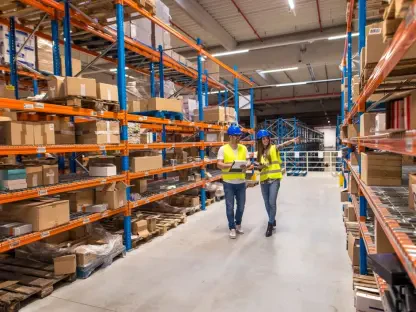As the holiday shopping season approaches, U.S. retailers face an unprecedented test of their supply chain resilience, with consumer demand peaking and global disruptions threatening timely deliveries. A staggering 70% of retail executives express concern that supply chain issues could derail holiday sales, setting the stage for a critical discussion on whether the industry is equipped to handle the crunch. This roundup gathers insights from various industry perspectives, including executive concerns, frontline worker experiences, and expert opinions on technological solutions, to assess readiness and explore strategies for navigating the chaos of the holiday rush.
Unraveling the Holiday Supply Chain Crisis
Executive Concerns: Stock Shortages Loom Large
Retail leaders across the sector are sounding the alarm over potential supply chain breakdowns as the holiday peak nears. Surveys indicate that a significant majority—around 70%—anticipate disruptions that could negatively impact sales during this crucial period. Many fear that insufficient inventory will leave shelves bare, with 64% specifically worried about meeting consumer demand, especially for online orders that require rapid fulfillment.
Beyond the numbers, there’s a palpable tension among executives about balancing stock levels amid unpredictable global logistics challenges. Some argue that these concerns might be amplified by past disruptions, suggesting a cautious but potentially overreactive stance. Others, however, view the apprehension as a necessary wake-up call, pushing for urgent investment in more robust supply systems to safeguard holiday revenue.
A recurring theme in these discussions is the cascading effect of stock shortages on customer loyalty. Industry leaders emphasize that failing to deliver during the holidays could tarnish brand reputation for months, if not years. This perspective highlights a shared urgency to address vulnerabilities now, before shoppers turn to competitors with better-prepared operations.
Frontline Realities: Inventory Discrepancies Fuel Stress
Shifting focus to store floors, retail workers paint a stark picture of operational challenges that compound executive fears. Over 80% of frontline staff report frequent mismatches between online “in stock” listings and actual store availability, creating confusion and frustration during high-pressure holiday shifts. This discrepancy often leads to wasted time and disappointed customers seeking promised items.
Compounding the issue, nearly three-quarters of these workers—73%—note price inconsistencies across sales channels, further complicating transactions and testing patience. About 30% identify stock shortages as their primary stressor, underscoring how these gaps directly impact daily workflows and morale in an already demanding season.
The broader implication is a potential erosion of trust from shoppers who rely on accurate information to plan purchases. Frontline insights suggest that without immediate fixes, retailers risk losing competitive edge as customers gravitate toward businesses with smoother operations. This ground-level feedback reveals a critical disconnect that must be bridged to maintain holiday momentum.
Technological Solutions: A Beacon of Hope
Amid the uncertainty, many industry voices point to technology as a potential game-changer for managing holiday supply chain chaos. AI-driven forecasting tools and real-time inventory tracking systems are frequently cited as innovations that could predict demand spikes and prevent stockouts. Proponents argue that such tools enable retailers to shift toward pull-based supply chains, adapting dynamically to consumer needs.
However, opinions diverge on the accessibility of these solutions. Larger retailers with substantial budgets are often seen as better positioned to adopt cutting-edge systems, potentially widening the gap with smaller players. Some experts caution that technology, while promising, isn’t a silver bullet, especially if implementation lags or staff training falls short during peak times.
A balanced view emerging from these discussions is the need for scalable tech options that cater to diverse retail sizes. Advocates stress that partnerships with tech providers could democratize access to advanced tools, ensuring even smaller chains aren’t left behind. This perspective fuels hope that innovation can level the playing field if prioritized strategically.
Human-Centric Approaches: Supporting Frontline Teams
Another key area of focus in industry conversations is the role of frontline workers in overcoming holiday hurdles. Many agree that empowering staff with digital tools—such as mobile inventory trackers—could significantly reduce the burden of manual stock checks and improve shopper interactions. This approach is seen as a way to transform retail roles into more efficient and satisfying positions.
Contrasting views highlight current limitations, with a notable portion of workers still lacking access to real-time data. Some industry observers suggest that without addressing this gap, retailers miss out on immediate productivity gains that could ease holiday stress. Others push for a longer-term vision, where tech integration reshapes how staff engage with both inventory and customers.
A compelling point raised in these discussions is the link between employee support and customer loyalty. Retail thought leaders note that investing in worker tools and training not only boosts operational flow but also fosters a positive shopping environment. This human element is often cited as a cornerstone for sustained success during high-stakes seasons like the holidays.
Strategies for Holiday Readiness
Drawing from varied insights, a consensus emerges on actionable steps retailers can take to brace for the holiday rush. Adopting AI for demand forecasting stands out as a top recommendation, with many believing it can preempt shortages by aligning inventory with real-time trends. Equipping staff with accessible tracking tools also garners strong support as a means to minimize in-store disruptions.
For retailers of all sizes, collaboration with technology providers is frequently advised to overcome budget constraints and accelerate implementation. Training programs tailored to peak demand periods are another focal point, aimed at enhancing staff agility when pressure mounts. These strategies collectively underscore a push for proactive, tech-supported resilience.
Beyond tools and training, some voices emphasize the importance of flexible logistics partnerships to buffer against global supply shocks. This approach, while less tech-centric, is seen as a practical complement to digital solutions, ensuring redundancy in delivery networks. Together, these ideas form a multifaceted blueprint for navigating the holiday landscape with confidence.
Reflecting on the Roundup Insights
Looking back on this exploration of holiday supply chain challenges, it becomes clear that U.S. retailers face significant hurdles, with executive fears of stock shortages and frontline struggles with inventory mismatches dominating the discourse. Diverse perspectives from industry leaders and workers alike illuminate the urgency of addressing these issues, while technological innovations offer a promising path forward. The debate around accessibility and human-centric solutions adds depth to the conversation, revealing both immediate needs and long-term opportunities.
Moving ahead, retailers are encouraged to prioritize investments in scalable AI tools and real-time tracking systems to bolster readiness for future holiday seasons. Partnering with tech firms and focusing on employee empowerment emerge as vital steps to close operational gaps. Additionally, exploring flexible supply chain models could provide a critical safety net against unforeseen disruptions, ensuring smoother operations in the years ahead.









